What Does the “p” in pH Mean?

The “p” in pH stands for the negative logarithm (−log) of the hydrogen ion concentration. This meaning extends to related notations such as pKa, pOH, and others where “p” universally indicates taking the negative log of a quantity. Despite some confusion and speculation, this interpretation is widely accepted and standard in chemistry.
Understanding “p” as the Negative Logarithm

The letter “p” represents the mathematical operation of calculating the negative logarithm of a value. For pH, it means:
pH = -log[H+]
Similarly, for acidity constants it is:
pKa = -log(Ka)
This implies the “p” converts the concentration or equilibrium constant into a more manageable scale. The logarithmic scale compresses large ranges of values into convenient numbers. For example, pH condenses hydrogen ion concentration spanning many orders of magnitude into a scale roughly from 0 to 14.
Clarifying Confusions: p vs. Greek Letter Rho (ρ)
A common mistake is mistaking the “p” in pH for the Greek letter rho (ρ). They are unrelated.
- p = negative logarithm function.
- ρ = symbol for density or resistivity in physics and chemistry.
The symbols have different origins and meanings. The use of lowercase “p” to denote negative logarithm is a convenient shorthand and does not reflect density or other properties represented by rho.
The Historical Origin of “p” in pH
The exact historical reason for choosing “p” is uncertain. The scientist who introduced the pH concept did not provide formal documentation explaining the choice.
- Many sources indicate the meaning of “p” has been lost to history.
- Some speculate it represents the German word Potenz, meaning “power” or “exponent.”
- Others suggest it relates to Latin or English terms such as “pondus” (weight) or “potential.”
Due to a lack of conclusive archival evidence, definitive etymology remains speculative. The widespread use of “p” as negative log in many chemical notations supports the idea it represents a “power” or “logarithmic” function rather than a physical quantity.
Common Interpretations and Hypotheses About “p”
Various explanations and teaching traditions exist:
- Potential of Hydrogen: The term potentia hydrogenii or “potential of hydrogen” is often taught. This frames pH as a measure of hydrogen ion potential.
- Power or Potenz: The “p” might come from German “Potenz,” referring to the exponent or logarithmic power in mathematics.
- Proportion: Some consider “p” as proportion or measure of hydrogen ion concentration in solution.
While these interpretations add helpful context, they all align on the functional role of “p” as making the scale logarithmic and intuitive.
Why Use Logarithms in pH Measurement?
Physiochemical properties like acidity vary across wide concentration ranges. Using raw concentration values would be cumbersome.
A logarithmic scale offers multiple benefits:
- It compresses large numeric ranges into small, manageable numbers.
- It offers intuitive multiplicative comparisons: each pH unit change equals a ten-fold change in hydrogen ion concentration.
- It reflects the magnitude of acidity/basicity without showing precise concentrations, which are often tiny or huge numbers.
For example, a pH of 1 means[H+] = 10−1 M, or 0.1 M. A pH of 2 means 0.01 M, which is 10 times less acidic.
At a pH of 14, the hydrogen ion concentration is 10−14 M, representing very low acidity, i.e. a highly basic solution.
Summary of Key Points
- The “p” in pH stands for the negative logarithm (−log) of hydrogen ion concentration.
- “p” is distinct from the Greek letter rho (ρ), which symbolizes density.
- The original reason for the letter “p” is not fully documented, but common hypotheses link it to “power,” “potential,” or “proportion.”
- Using a logarithmic scale condenses wide-ranging concentrations into a simple, interpretable numeric scale.
- pH changes imply tenfold changes in acidity, making the scale practical for chemistry and biology.
The Enigma of the p in pH: What Does It Really Mean?
If you’ve ever wondered, “The p in pH isn’t known?” you’re not alone. Chemists, students, and curious minds have debated this puzzle for decades. What does that little p actually stand for? Is it just a letter? A symbol? A lost relic of scientific history? Buckle up, because we’re diving into the quirky, sometimes confusing backstory of the p in pH and its chemical cousins.
So, What Does the p in pH Stand For?
At a minimum, “p” means the negative logarithm. Yes, that’s it. Simple, elegant, and functional. If you see pH = -log[H], the p is shorthand for taking the negative log of the hydrogen ion concentration. This pattern isn’t unique to pH. Think pKa = -log(Ka), or even pOH, all using the same ace: p = negative log.
Why negative logarithm? Because hydrogen ion concentrations can be ridiculously small and cumbersome. Expressing them on a logarithmic scale simplifies comparisons and understanding. For example, a pH of 1 is ten times more acidic than a pH of 2. So, this negative log trick takes us from tiny decimal numbers, like 10-14, to neat, manageable digits, like 14. Handy, right?
The p vs. Rho (ρ) Confusion: Clearing the Air
People sometimes confuse p with the Greek letter rho (ρ), mainly because “rho” is used in science too—but for something very different: density. Rho measures how heavy something is packed, while p is a function. It’s a big difference. So, despite online chatter, p is not rho. If you ever spot someone claiming otherwise, you can nod politely and move on.
Where Did This Mysterious “p” Come From? The Missing History
The simplest answer: nobody really knows. The man who introduced the pH notation, Søren Peter Lauritz Sørensen, never left a clear explanation of why he chose the letter p. It’s like ancient scientific graffiti—there but mysterious. Without notes or interviews, the true origin is lost to time.
This kind of mystery isn’t unique. Take Planck’s constant, for example: why “h”? No one’s entirely sure! Some scientific labels become traditions without documented origins.
Popular Theories About the p
- Potential or Power: Some say “p” stands for “potential” or “power,” borrowed from the German word Potenz. It fits nicely since pH measures the potential of hydrogen ions in solution.
- Pondus Hydrogenii: An old Latin phrase meaning “weight of hydrogen,” sometimes offered as the source for “p.” Translated loosely, it supports the “potential of hydrogen” interpretation, a phrase still commonly used.
- Proportion: Others learned that “p” might mean “proportion” of hydrogen or hydronium ions. This aligns with the idea that pH indicates how much acidic species are present in water relative to the whole.
Funny thing is, all these interpretations could be right or wrong—all we know is p means negative log, and the rest is guesswork. That’s science for you: curious, sometimes mysterious, but always useful.
Why Use the Logarithm Anyway?
Let’s take a sip from the chemistry cup here. Hydrogen ion concentration can vary over huge ranges—from super acidic battery acid to pure, neutral water. The numbers can be unwieldy—imagine saying “the concentration is 0.00000000000001 mol/L” instead of “pH 14.”
Using a logarithmic scale condenses this range into digestible numbers. It not only helps chemists communicate clearly but reveals the scale intuitively. Each increase or decrease by 1 pH unit means a tenfold change in acidity or basicity.
So, even if the choice of p is shrouded in mystery, the logarithm itself is a functional and clever way to report chemical realities.
What Does This Mean for You?
Next time you hear “the p in pH isn’t known,” you can nod knowingly. It’s a delightful blend of certainty and mystery in science. You know that p equals the negative logarithm, making acidity easier to grasp. But you can also appreciate the historical gap—the original reasoning lost in translation, time, or perhaps the lack of a “why” from Sørensen himself.
This knowledge gives you an edge in conversations and studies. It reminds you that even in highly precise fields, some things remain delightfully ambiguous. Sometimes, the story behind the symbol is as interesting as the science it describes.
Bottom Line: What’s the Final Word on the p?
The p in pH, pKa, and related terms universally means “negative logarithm.” However, why the letter p was chosen remains a mystery. Theories range from Latin to German origins and ideas about proportion or potential. Despite these guesses, none is definitively proven.
What’s not in doubt, though, is the value of this notation: it makes chemistry elegant, manageable, and communicateable across disciplines worldwide.
Got a Question? Let’s Ponder It Together!
Why do you think scientists stick with a notation whose origins aren’t totally clear? Could it be tradition? The power of convention? Or just convenience? Share your thoughts and let’s keep the conversation bubbling!
What does the “p” in pH actually stand for?
The “p” stands for the negative logarithm. It means pH = -log[H+]. This notation is used consistently in chemistry, like in pKa and pOH. It is not a Greek letter but a symbol for logarithmic scale.
Is the “p” in pH the Greek letter rho (ρ)?
No, “p” is not rho. The letter “p” represents a logarithmic function, while rho (ρ) represents density. They are entirely different symbols with different meanings.
Why is the origin of the letter “p” in pH unclear?
The original creator did not explain the choice of “p”. There is no documented reason, so its exact origin remains uncertain. Scientists have only hypotheses about its meaning.
What are some common theories about what “p” stands for?
Many think “p” means “potential” or “power,” derived from German “Potenz.” Others say it refers to “proportion” of hydrogen or hydronium ions.
Why use a logarithm in the definition of pH?
Logarithms turn tiny proton concentrations into manageable numbers. For example, a pH of 1 means 10 times more acidic than pH 2, making acidity easier to compare and understand.





Leave a Comment